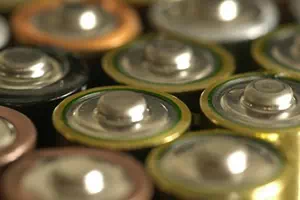 |
| EPA clarifies the regulatory of spent lithium batteries - they are Hazardous Waste (D001 and D003) and can be recycled as Universal Waste. |
Types of Batteries
Alkaline: Common batteries in various sizes, including AAA, AA, C, D, 9-volt. Typically contain zinc and manganese dioxide.
Lead-acid: Used in vehicles, wheelchairs, forklifts, and portable generators. Contain lead.
Lithium: Used in numerous devices and solar panels. Lithium batteries are likely to be considered hazardous waste because they are ignitable (D001) and reactive (D003). They contain lithium, nickel, and lead.
Mercuric oxide: Also known as ‘button’ batteries. Used in hearing aids, cameras, smoke detectors, tape recorders, electronic computers, voltage regulators, pagers, oxygen monitors, fetal monitors, portable EKG monitors, and until recently, in cardiac pacemakers. Contain mercury.
Nickel-cadmium: Rechargeable batteries used in calculators, handheld tools, alarm systems, pages and as back-up power sources in medical monitors and equipment (usually built in by manufacturer). Although these are rechargeable and can be used many times, they eventually need to be disposed of and contain high levels of nickel and cadmium.
Silver cadmium: Used in medical electronics and require high-energy density and constant voltage. Contain silver and cadmium.
Zinc-air: This button battery has been developed as an alternative to the mercuric oxide battery, though it is not mercury free. It is used in such devices as hearing aids and electronic pagers. Contains zinc and mercury.
Risks
- When batteries are incinerated, the heavy metals in them can contaminate the incinerator ash and air.
- Heavy metals from batteries can leach out of landfills and pollute water sources.
- Heavy metals have whole host of neurological effects on humans… lead, mercury and cadmium are well-documented.
Compliance Requirements
- • Most batteries, other than alkalines, are regulated hazardous waste due to being ignitable (D001), reactive (D003) and/or toxic.
- If you are going to treat them as solid waste, rather than hazardous waste, make sure you have documentation that they have passed TCLP tests.
- If you do determine them to be hazardous, they can be treated as universal waste if your state has adopted the federal regulations on Universal Waste. This will allow you to subtract the weight of battery waste from your hazardous waste totals, and allow you some lenience in packing and transportation requirements.
- They need to be packaged in a non-flammable container and the ends must be capped/wrapped to prevent sparking.
Alternatives
(Not many alternatives… just need to recycle them.)
Battery Recycling
- Non-flammable containers
- Tape ends to prevent sparking
- Offer alkaline batteries to staff to use in Walkmans, toys etc. as most batteries are only used once and changed our immediately after the procedure regardless of charge left.
- Work with Universal Waste hauler
- Haulers often supply containers and you pay by the ‘bucket’
- Battery collection containers can go in soiled utility rooms if properly labeled, proper containers, proper packaging
- Hold Battery Round-up for staff
More Resources
Used Lithium Batteries (US EPA). Most lithium-ion batteries on the market are likely to meet the definition of hazardous waste under the Resource Conservation and Recovery Act (RCRA). The universal waste regulations apply to lithium batteries and provide a streamlined set of requirements for generators.
Mercury-Containing and Rechargeable Battery Act (PDF): https://www.epa.gov/rcra/mercury-containing-and-rechargeable-battery-management-act-public-law-104-142



